2015 TOYOTA AVENSIS warning
[x] Cancel search: warningPage 559 of 648
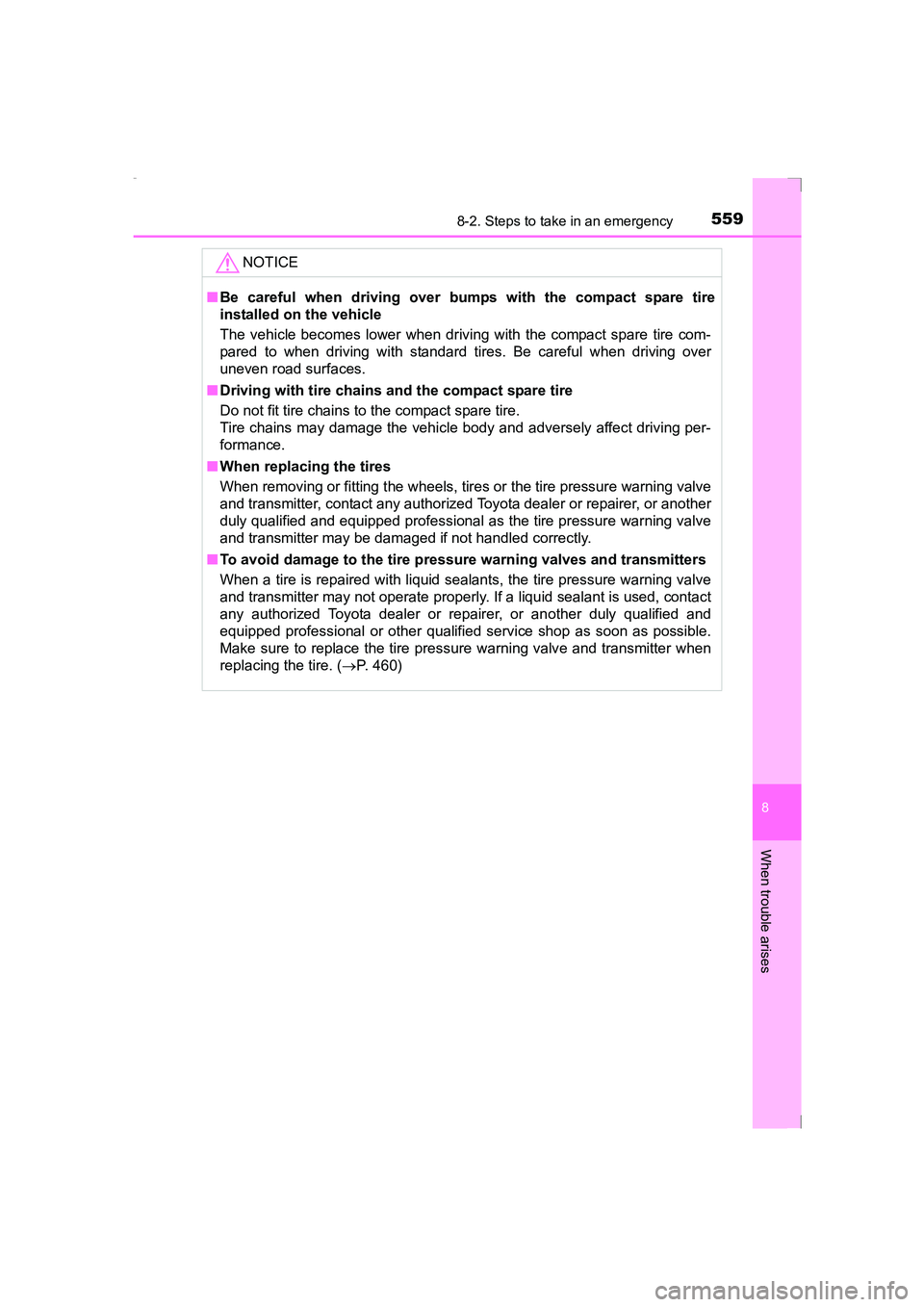
5598-2. Steps to take in an emergency
AVENSIS_OM_OM20C20E_(EE)
8
When trouble arises
NOTICE
■Be careful when driving over bumps with the compact spare tire
installed on the vehicle
The vehicle becomes lower when driving with the compact spare tire com-
pared to when driving with standard tires. Be careful when driving over
uneven road surfaces.
■ Driving with tire chains and the compact spare tire
Do not fit tire chains to the compact spare tire.
Tire chains may damage the vehicle body and adversely affect driving per-
formance.
■ When replacing the tires
When removing or fitting the wheels, tires or the tire pressure warning valve
and transmitter, contact any authorized Toyota dealer or repairer, or another
duly qualified and equipped professional as the tire pressure warning valve
and transmitter may be damaged if not handled correctly.
■ To avoid damage to the tire pressure warning valves and transmitters
When a tire is repaired with liquid sealants, the tire pressure warning valve
and transmitter may not operate properly. If a liquid sealant is used, contact
any authorized Toyota dealer or repairer, or another duly qualified and
equipped professional or other qualified service shop as soon as possible.
Make sure to replace the tire pres sure warning valve and transmitter when
replacing the tire. ( →P. 460)
AVENSIS_OM_OM20C20E_(EE).book Page 559 Thursday, January 29, 2015 1:47 PM
Page 560 of 648
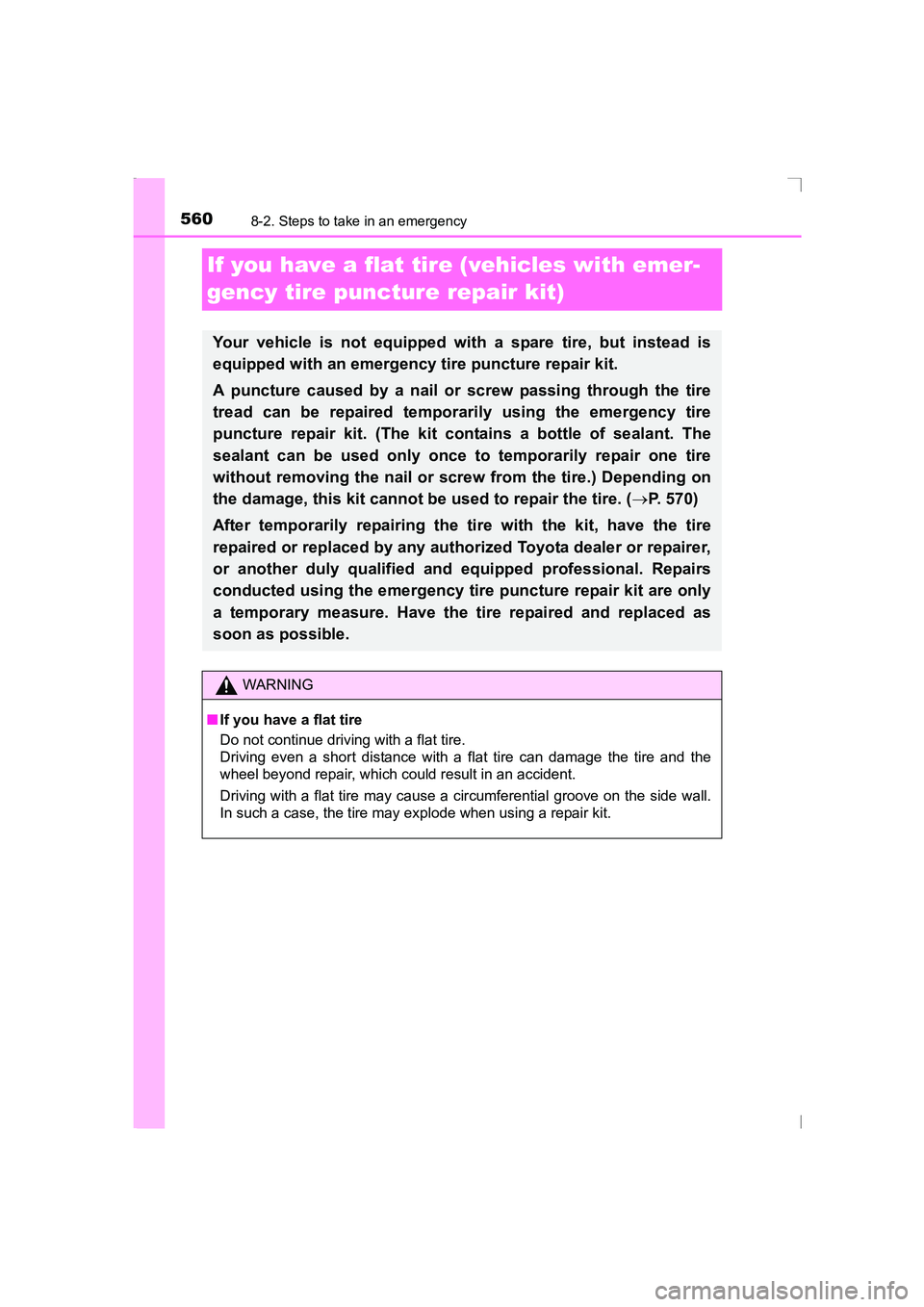
5608-2. Steps to take in an emergency
AVENSIS_OM_OM20C20E_(EE)
If you have a flat tire (vehicles with emer-
gency tire puncture repair kit)
Your vehicle is not equipped with a spare tire, but instead is
equipped with an emergency tire puncture repair kit.
A puncture caused by a nail or screw passing through the tire
tread can be repaired temporarily using the emergency tire
puncture repair kit. (The kit contains a bottle of sealant. The
sealant can be used only once to temporarily repair one tire
without removing the nail or screw from the tire.) Depending on
the damage, this kit cannot be used to repair the tire. (→P. 570)
After temporarily repairing the tire with the kit, have the tire
repaired or replaced by any authorized Toyota dealer or repairer,
or another duly qualified and equipped professional. Repairs
conducted using the emergency tire puncture repair kit are only
a temporary measure. Have the tire repaired and replaced as
soon as possible.
WARNING
■ If you have a flat tire
Do not continue driving with a flat tire.
Driving even a short distance with a flat tire can damage the tire and the
wheel beyond repair, which could result in an accident.
Driving with a flat tire may cause a circumferential groove on the side wall.
In such a case, the tire may explode when using a repair kit.
AVENSIS_OM_OM20C20E_(EE).book Page 560 Thursday, January 29, 2015 1:47 PM
Page 571 of 648
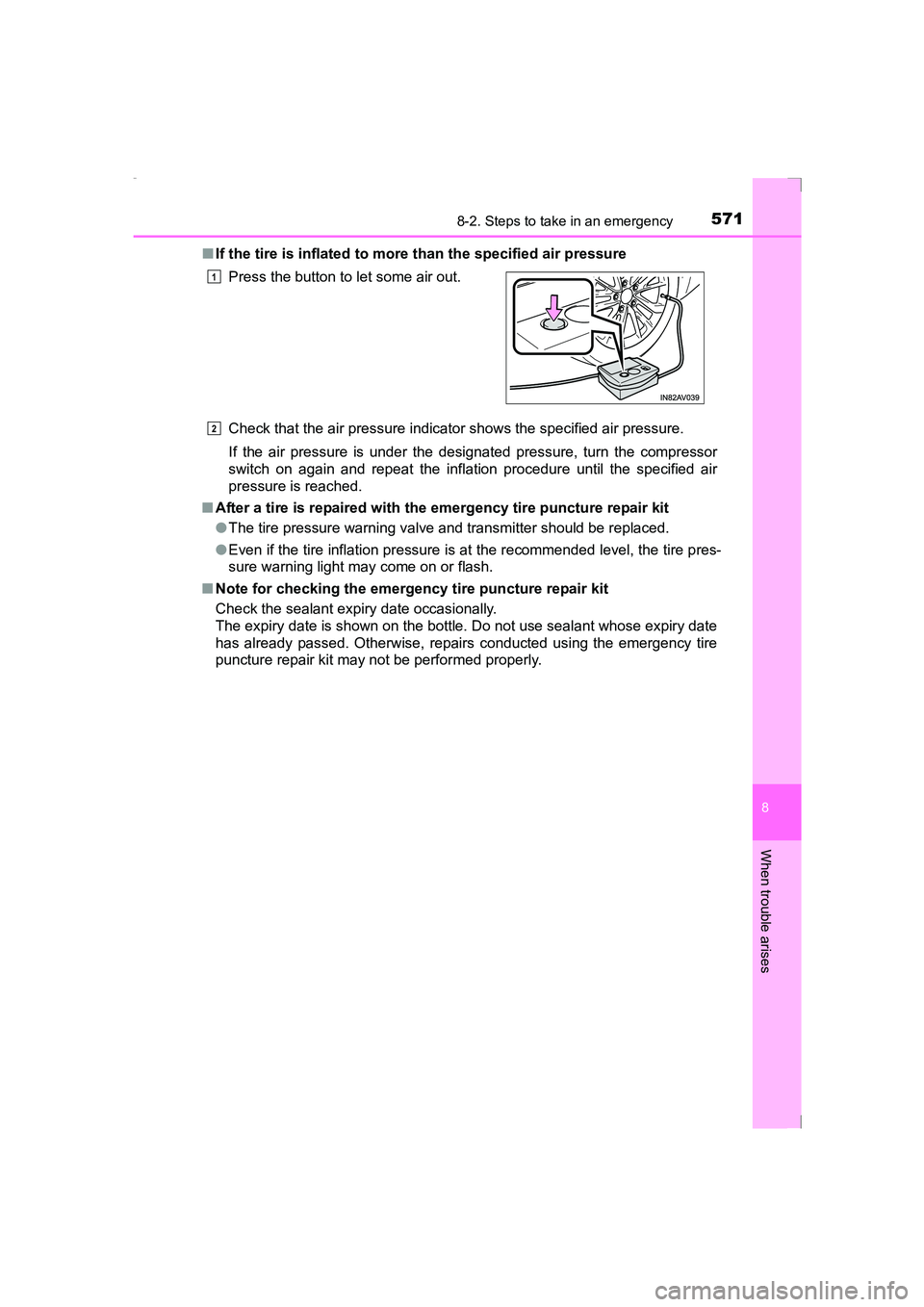
5718-2. Steps to take in an emergency
AVENSIS_OM_OM20C20E_(EE)
8
When trouble arises
■If the tire is inflated to mo re than the specified air pressure
Check that the air pressure indicator shows the specified air pressure.
If the air pressure is under the designated pressure, turn the compressor
switch on again and repeat the inflation procedure until the specified air
pressure is reached.
■ After a tire is repaired with the emergency tire puncture repair kit
●The tire pressure warning valve and transmitter should be replaced.
● Even if the tire inflation pressure is at the recommended level, the tire pres-
sure warning light may come on or flash.
■ Note for checking the emergency tire puncture repair kit
Check the sealant expiry date occasionally.
The expiry date is shown on the bottle. Do not use sealant whose expiry date
has already passed. Otherwise, repairs conducted using the emergency tire
puncture repair kit may not be performed properly.Press the button to let some air out.
1
2
AVENSIS_OM_OM20C20E_(EE).book Page 571 Thursday, January 29,
2015 1:47 PM
Page 572 of 648
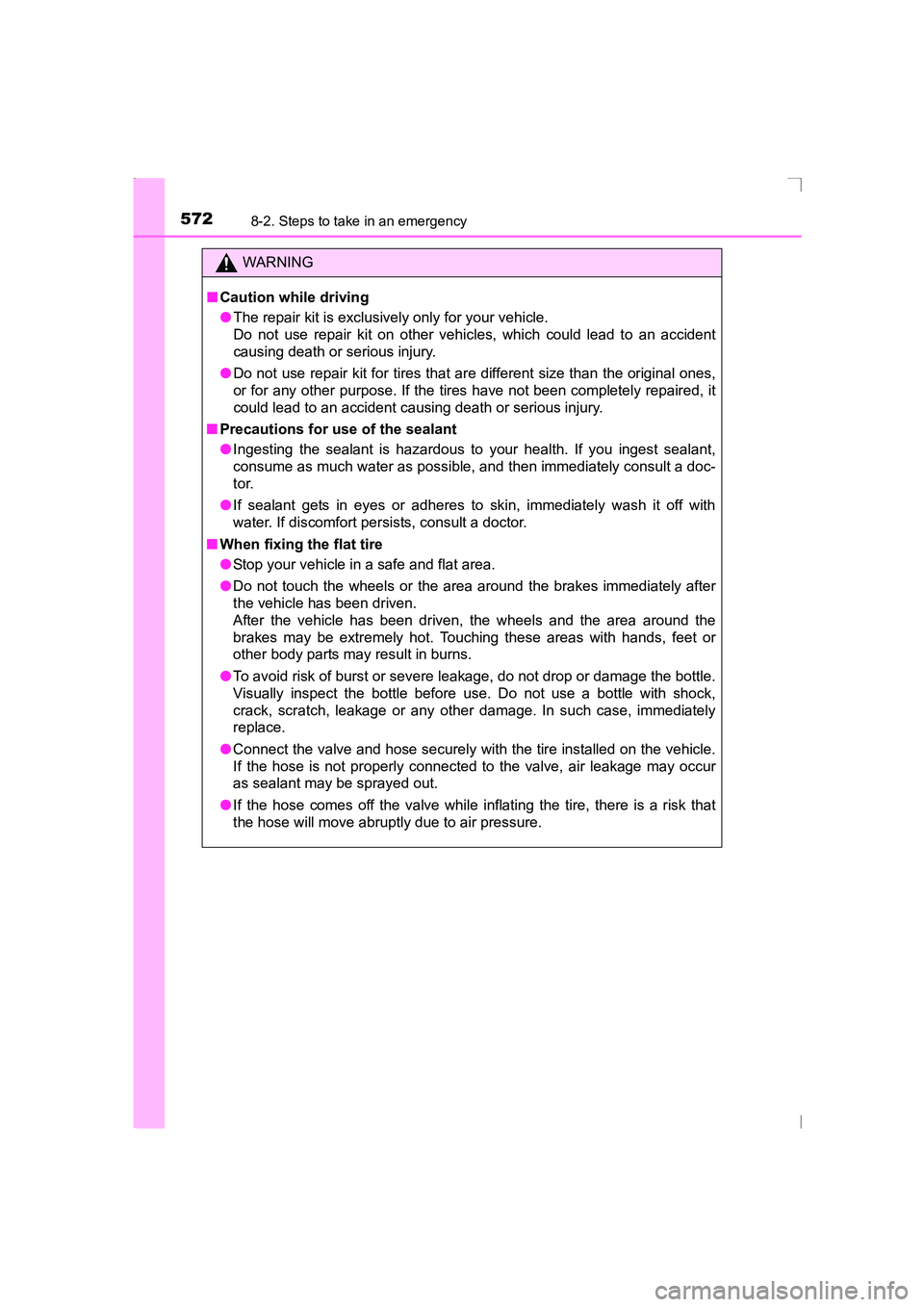
5728-2. Steps to take in an emergency
AVENSIS_OM_OM20C20E_(EE)
WARNING
■ Caution while driving
●The repair kit is exclusively only for your vehicle.
Do not use repair kit on other vehicles, which could lead to an accident
causing death or serious injury.
● Do not use repair kit for tires that are different size than the original ones,
or for any other purpose. If the tires have not been completely repaired, it
could lead to an accident causing death or serious injury.
■ Precautions for use of the sealant
●Ingesting the sealant is hazardous to your health. If you ingest sealant,
consume as much water as possible, and then immediately consult a doc-
tor.
● If sealant gets in eyes or adheres to skin, immediately wash it off with
water. If discomfort persists, consult a doctor.
■ When fixing the flat tire
●Stop your vehicle in a safe and flat area.
● Do not touch the wheels or the area around the brakes immediately after
the vehicle has been driven.
After the vehicle has been driven, the wheels and the area around the
brakes may be extremely hot. Touching these areas with hands, feet or
other body parts may result in burns.
● To avoid risk of burst or severe leakage, do not drop or damage the bottle.
Visually inspect the bottle before use. Do not use a bottle with shock,
crack, scratch, leakage or any other damage. In such case, immediately
replace.
● Connect the valve and hose securely with the tire installed on the vehicle.
If the hose is not properly connected to the valve, air leakage may occur
as sealant may be sprayed out.
● If the hose comes off the valve while inflating the tire, there is a risk that
the hose will move abruptly due to air pressure.
AVENSIS_OM_OM20C20E_(EE).book Page 572 Thursday, January 29, 2015 1:47 PM
Page 573 of 648

5738-2. Steps to take in an emergency
AVENSIS_OM_OM20C20E_(EE)
8
When trouble arises
WARNING
■ When fixing the flat tire
●After inflation of the tire has completed, the sealant may splatter when the
hose is disconnected or some air is let out of the tire.
● Follow the operation procedure to repair the tire. If the procedures not fol-
lowed, the sealant may spray out.
● Keep back from the tire while it is being repaired, as there is a chance of it
bursting while the repair operation is being performed. If you notice any
cracks or deformation of the tire, turn off the compressor switch and stop
the repair operation immediately.
● The repair kit may overheat if operated for a long period of time. Do not
operate the repair kit continuously for more than 40 minutes.
● Parts of the repair kit become hot during operation. Be careful when han-
dling the repair kit during and after operation. Do not touch the metal part
around the connecting area between the bottle and compressor. It will be
extremely hot.
● Do not attach the vehicle speed warning sticker to an area other than the
one indicated. If the sticker is attached to an area where an SRS airbag is
located, such as the pad of the steering wheel, it may prevent the SRS air-
bag from operating properly.
■ Driving to spread the liquid sealant evenly
Observe the following precautions to reduce the risk of accidents.
Failing to do so may result in a loss of vehicle control and cause death or
serious injury.
●Drive the vehicle carefully at a low speed. Be especially careful when turn-
ing and cornering.
● If the vehicle does not drive straight or you feel a pull through the steering
wheel, stop the vehicle and check the following:
• Tire condition. The tire may have separated from the wheel.
• Tire inflation pressure. If the tire inflation pressure is 130 kPa (1.3 kgf/cm
2
or bar, 19 psi) or less, the tire may be severely damaged.
AVENSIS_OM_OM20C20E_(EE).book Page 573 Thursday, January 29, 2015 1:47 PM
Page 574 of 648
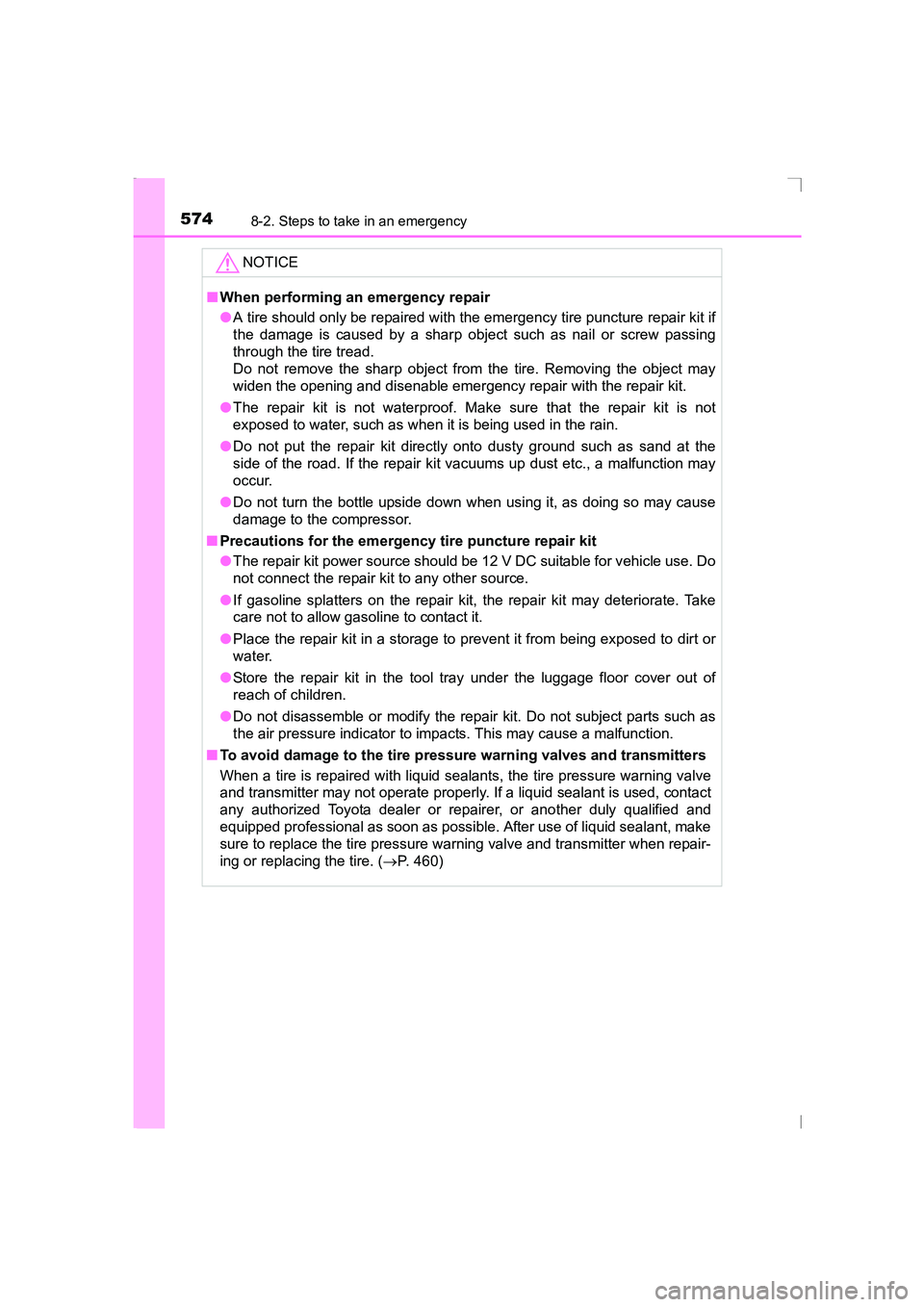
5748-2. Steps to take in an emergency
AVENSIS_OM_OM20C20E_(EE)NOTICE
■
When performing an emergency repair
●A tire should only be repaired with the emergency tire puncture repair kit if
the damage is caused by a sharp object such as nail or screw passing
through the tire tread.
Do not remove the sharp object from the tire. Removing the object may
widen the opening and disenable emergency repair with the repair kit.
● The repair kit is not waterproof. Make sure that the repair kit is not
exposed to water, such as when it is being used in the rain.
● Do not put the repair kit directly onto dusty ground such as sand at the
side of the road. If the repair kit vacuums up dust etc., a malfunction may
occur.
● Do not turn the bottle upside down when using it, as doing so may cause
damage to the compressor.
■ Precautions for the emergency tire puncture repair kit
●The repair kit power source should be 12 V DC suitable for vehicle use. Do
not connect the repair kit to any other source.
● If gasoline splatters on the repair kit, the repair kit may deteriorate. Take
care not to allow gasoline to contact it.
● Place the repair kit in a storage to prevent it from being exposed to dirt or
water.
● Store the repair kit in the tool tray under the luggage floor cover out of
reach of children.
● Do not disassemble or modify the repair kit. Do not subject parts such as
the air pressure indicator to impacts. This may cause a malfunction.
■ To avoid damage to the tire pressure warning valves and transmitters
When a tire is repaired with liquid sealants, the tire pressure warning valve
and transmitter may not operate properly. If a liquid sealant is used, contact
any authorized Toyota dealer or repairer, or another duly qualified and
equipped professional as soon as possible. After use of liquid sealant, make
sure to replace the tire pressure warning valve and transmitter when repair-
ing or replacing the tire. ( →P. 460)
AVENSIS_OM_OM20C20E_(EE).book Page 574 Thursday, January 29, 2015 1:47 PM
Page 581 of 648
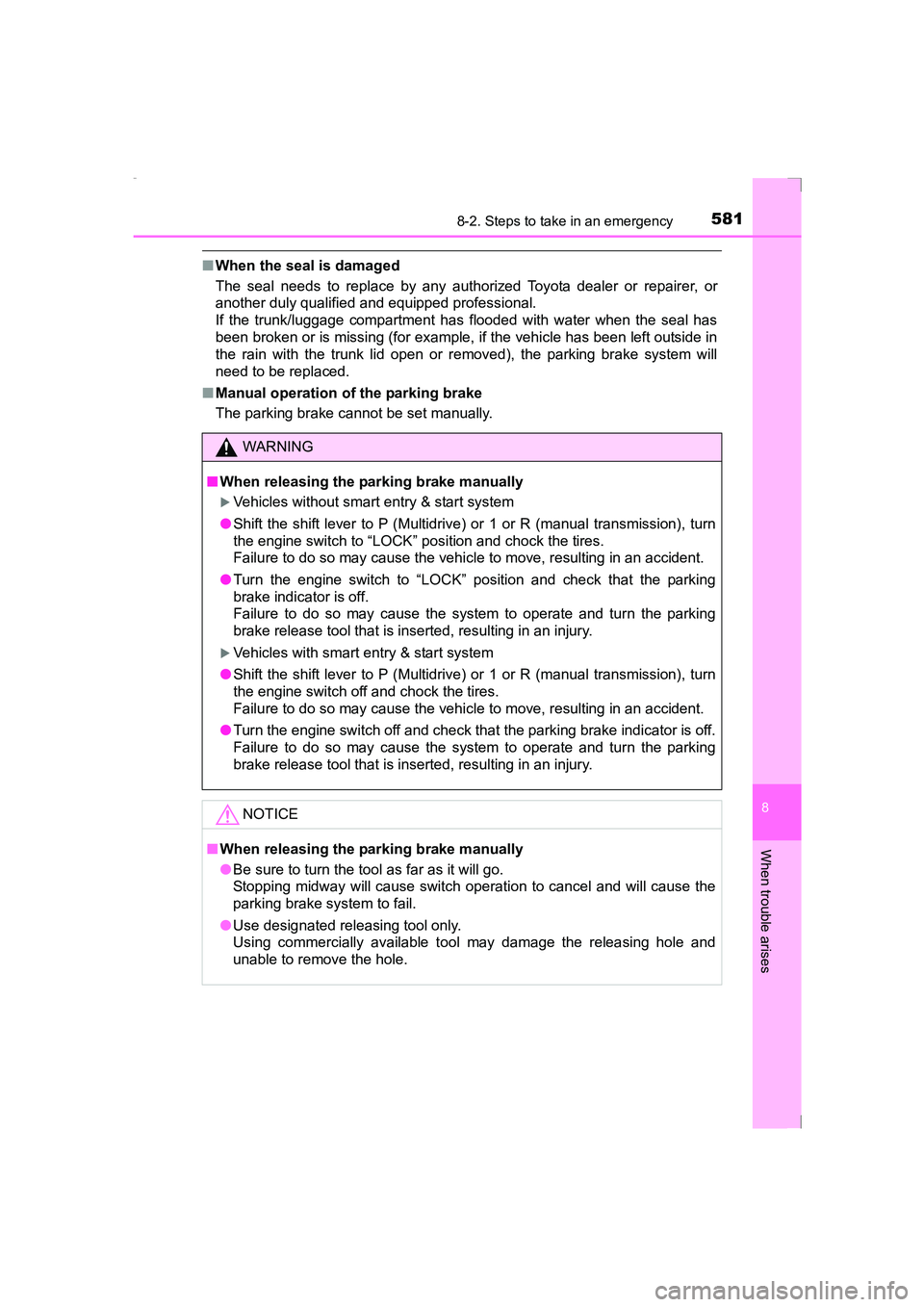
5818-2. Steps to take in an emergency
AVENSIS_OM_OM20C20E_(EE)
8
When trouble arises
■When the seal is damaged
The seal needs to replace by any aut horized Toyota dealer or repairer, or
another duly qualified and equipped professional.
If the trunk/luggage compartment has flooded with water when the seal has
been broken or is missing (for example, if the vehicle has been left outside in
the rain with the trunk lid open or removed), the parking brake system will
need to be replaced.
■ Manual operation of the parking brake
The parking brake cannot be set manually.
WARNING
■ When releasing the parking brake manually
�XVehicles without smart entry & start system
● Shift the shift lever to P (Multidrive) or 1 or R (manual transmission), turn
the engine switch to “LOCK” position and chock the tires.
Failure to do so may cause the vehicle to move, resulting in an accident.
● Turn the engine switch to “LOCK” position and check that the parking
brake indicator is off.
Failure to do so may cause the system to operate and turn the parking
brake release tool that is inserted, resulting in an injury.
�XVehicles with smart entry & start system
● Shift the shift lever to P (Multidrive) or 1 or R (manual transmission), turn
the engine switch off and chock the tires.
Failure to do so may cause the vehicle to move, resulting in an accident.
● Turn the engine switch off and check that the parking brake indicator is off.
Failure to do so may cause the system to operate and turn the parking
brake release tool that is inserted, resulting in an injury.
NOTICE
■ When releasing the parking brake manually
●Be sure to turn the tool as far as it will go.
Stopping midway will cause switch operation to cancel and will cause the
parking brake system to fail.
● Use designated releasing tool only.
Using commercially available tool may damage the releasing hole and
unable to remove the hole.
AVENSIS_OM_OM20C20E_(EE).book Page 581 Thursday, January 29, 2015 1:47 PM
Page 588 of 648
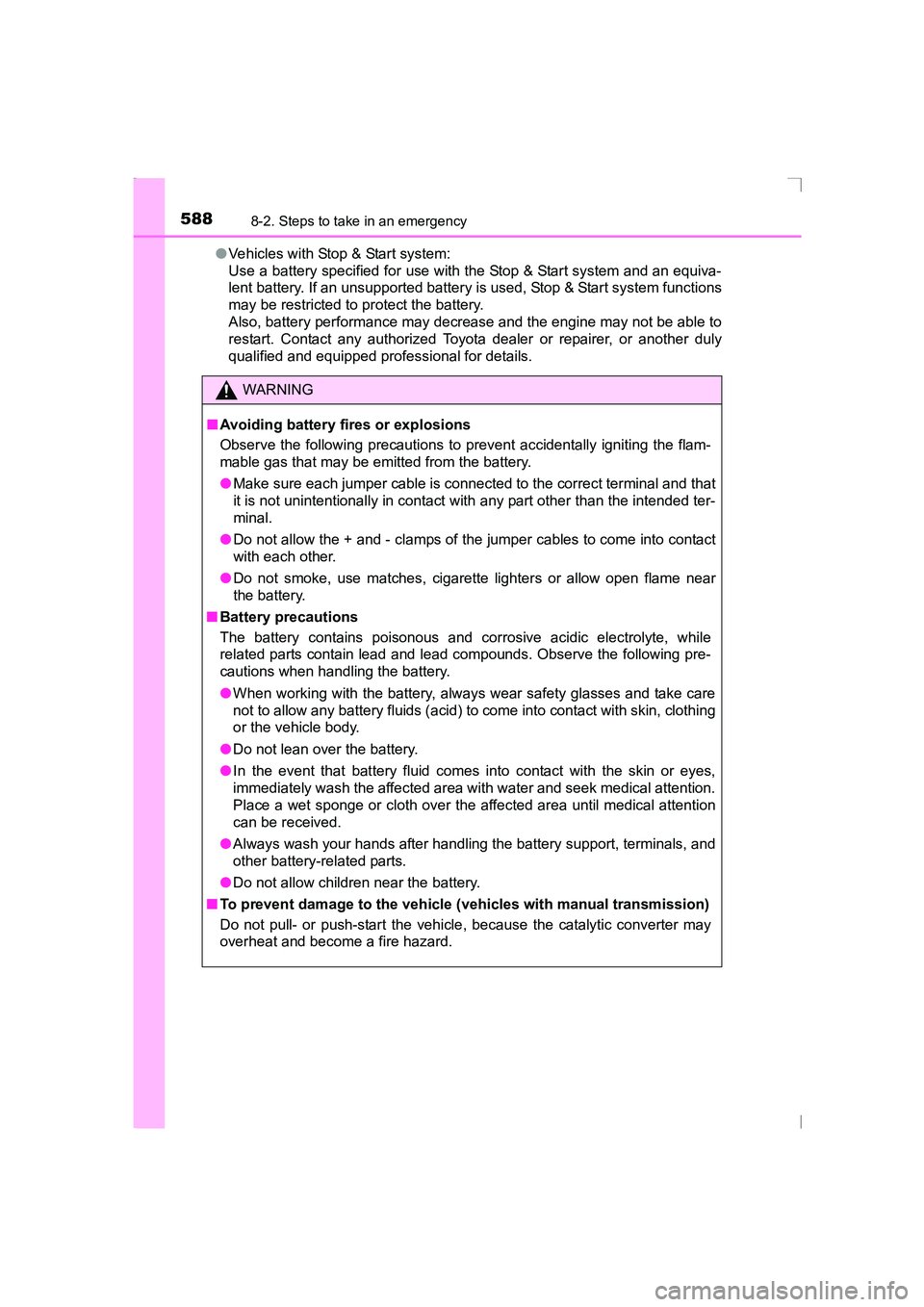
5888-2. Steps to take in an emergency
AVENSIS_OM_OM20C20E_(EE)●
Vehicles with Stop & Start system:
Use a battery specified for use with the Stop & Start system and an equiva-
lent battery. If an unsupported battery is used, Stop & Start system functions
may be restricted to protect the battery.
Also, battery performance may decrease and the engine may not be able to
restart. Contact any authorized Toyota dealer or repairer, or another duly
qualified and equipped professional for details.
WARNING
■ Avoiding battery fires or explosions
Observe the following precautions to prevent accidentally igniting the flam-
mable gas that may be emitted from the battery.
● Make sure each jumper cable is connected to the correct terminal and that
it is not unintentionally in contact with any part other than the intended ter-
minal.
● Do not allow the + and - clamps of the jumper cables to come into contact
with each other.
● Do not smoke, use matches, cigarette lighters or allow open flame near
the battery.
■ Battery precautions
The battery contains poisonous and corrosive acidic electrolyte, while
related parts contain lead and lead compounds. Observe the following pre-
cautions when handling the battery.
●When working with the battery, always wear safety glasses and take care
not to allow any battery fluids (acid) to come into contact with skin, clothing
or the vehicle body.
● Do not lean over the battery.
● In the event that battery fluid comes into contact with the skin or eyes,
immediately wash the affected area with water and seek medical attention.
Place a wet sponge or cloth over the affected area until medical attention
can be received.
● Always wash your hands after handling the battery support, terminals, and
other battery-related parts.
● Do not allow children near the battery.
■ To prevent damage to the vehicle (vehicles with manual transmission)
Do not pull- or push-start the vehicl e, because the catalytic converter may
overheat and become a fire hazard.
AVENSIS_OM_OM20C20E_(EE).book Page 588 Thursday, January 29, 2015 1:47 PM